AWRI helpdesk project
Project summary
This project provides helpdesk support for technical problems encountered by Australian grapegrowers and winemakers. Support includes identifying the root causes of problems, and providing research-based, practical, up-to-date remediation solutions, as well as future prevention strategies. This service also ensures that Australian grapegrowers and winemakers are competitive on the world stage, by having the latest technical information readily to hand. Investigative services, including analysis of problem grapes or wine, are conducted when a problem cannot be solved through discussions with the producer.
Latest information
Helpdesk enquiries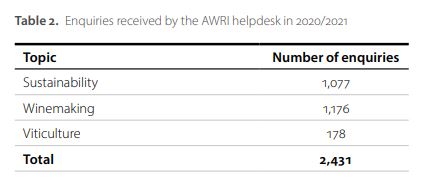
During 2020/2021, 2,431 enquiries were received (Table 2). Of these, 1,354 were wine and viticulture enquiries, significantly less than last year’s record number of queries, which resulted from the 2020 bushfire season. Sustainability enquiries continued to grow, almost double the number from last year, and the first year where more than 1,000 enquiries were received (Figure 2). The majority of enquiries were from grape and wine companies and suppliers actively aligned with the wine industry, with a small number coming from government organisations, students, legal practitioners and journalists. Figure 3 shows that the sources of enquiries were broadly in line with the proportional volume of wine-grape plantings for each state/territory.
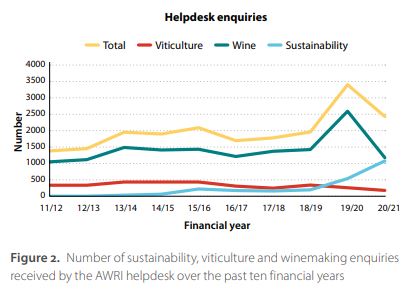
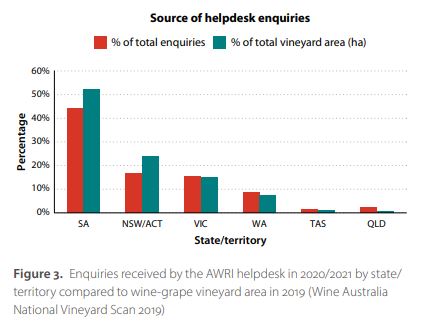
Helpdesk enquiries are now grouped using 20 subject keywords. The number of enquiries received under each keyword is compared to historical monthly data collected over more than 20 years, to help identify national, state and regional trends. This allows for prompt responses to emerging issues and timely provision of relevant information. Figure 4 shows the wine and viticulture enquiries from 2020/2021 arranged in order from most to least used keyword, highlighting key events or issues of interest during the year.
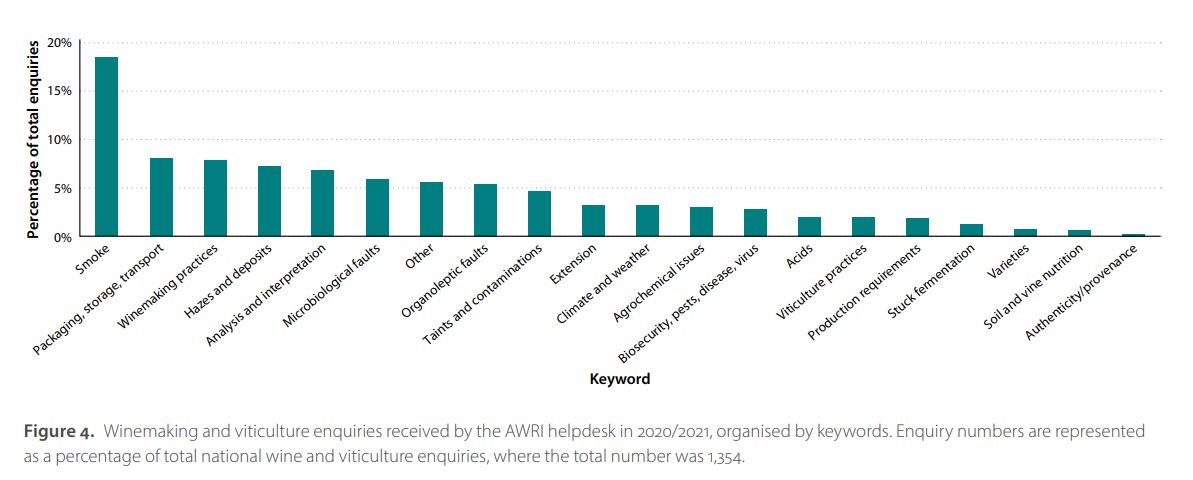
Sustainability enquiries
During the year, the sustainability team responded to 1,077 enquiries primarily from grape and wine producers, as well as state and regional associations and international enquirers. A high proportion of sustainability enquiries were received during the Sustainable Winegrowing Australia renewal period between July and August.
Viticultural enquiries
During the year, the viticulture team responded to 178 enquiries. The main topic of concern for growers was a La Niña event that occurred during the 2020/2021 growing season and the associated impacts from a wetter season. The AWRI held a webinar early in the season with Dr Paul Petrie from SARDI comparing the forecast La Niña event with previous events. There was concern that demand for fungicides registered for downy mildew might exceed supply and contingencies were prepared to deal with this, but in the end these were not required. Botrytis outbreaks were reported across regions in Victoria and NSW, and the AWRI later issued two eBulletins and held two further webinars on management of late-season Botrytis in the vineyard and winery. Overall, however, the helpdesk did not observe an increase in queries regarding increased disease pressure in vineyards or an increase in Botrytis-affected wines.
The pest insect fall armyworm, <e,>Spodoptera frugiperda, was first detected in northern Queensland in January 2020 and later in NSW in November 2020. This highly invasive pest has the potential to feed on grapevines but its behaviour is not well understood. Chemical controls were made available via Australian Pesticides and Veterinary Medicines Authority permits but were not required. Two eBulletins were produced to communicate to industry about this new pest, including options for its control.
Winemaking enquiries
Thanks to the cooler season, there were fewer extreme temperature days and a generally lower risk of bushfires – a welcome relief after the 2020 season. Despite this, the largest number of enquiries received by the helpdesk were on smoke taint, with fires occurring in the Adelaide Hills and the Limestone Coast, along with smaller spot or grass fires in the Barossa Valley and McLaren Vale, SA and Wooroloo in the Swan District, WA. A forecast wetter winter for 2021 raised the potential of a shorter window of opportunity to conduct prescribed or planned burns to reduce bushfire risk. Several states therefore brought forward the start of their burns to early March, which caused concerns from neighbouring wine regions with fruit still on the vine. The AWRI worked with state and regional bodies to provide accurate information on controlled burns and their impact on viticulture, to support communications with organisations conducting burns. A large number of queries on smoke taint answered by the helpdesk stemmed from wineries processing 2020 wines and investigations of ‘smoky’ sensory characters developing in wine over time in bottle. Some smoke-affected wines are being tasted and analysed for smoke compounds by the helpdesk team every three months to examine the impact of bottle age on smoke-affected wines.
Fewer heatwaves and an extended growing season also saw fewer stuck fermentations and associated problems, possibly because producers had both time and tank capacity to manage ferments appropriately rather than being challenged by vintage compression. Higher acidity levels (in many cases double the usual concentrations of malic acid) were reported, resulting in high initial titratable acidities in must and subsequent larger than expected pH increases post-malolactic fermentation.
One-third of the ‘packaging, storage and transport’ queries related to the use of sulfur dioxide (SO2), with queries covering appropriate concentrations for microbiological control, particularly for Brettanomyces yeast; typical losses of SO2 over time during bottle maturation or wine ageing; SO2 removal following over-additions during vintage; and SO2 bleaching of young red wines. Queries also covered the potential quality impacts of wine being held up in transit to China due to trade disputes. An increase in helpdesk queries categorised under ‘winemaking practices’ related to wineries seeking information on techniques such as carbonic maceration, skin contact, water addition, fortification, sweetening, use of dried grapes in ferments, fining, aeration of red ferments, and nutrient management and requirements of ferments. A new ‘winemaking practices’ section was added to the AWRI website to provide information on these types of topics.
Winemaking problem-solving investigations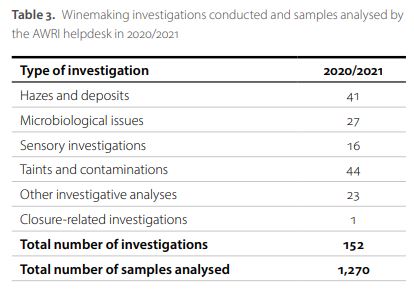
This year only 11% of winemaking enquiries resulted in investigations, where samples are requested and analysis performed to identify the problem and recommend a solution, a lower proportion than the longer-term average of 20%. The helpdesk team conducted 152 problem-solving investigations on 1,270 samples (Table 3). This was approximately 50 fewer investigations than most years; however, the number of samples submitted was higher than usual. This increase was due to higher numbers of investigations of quality variation, pressure and gushing in sparkling wines; microbiological variation in bottled stock; potential Brettanomyces contamination from a vineyard; and smoke development or indole degradation in bottle over time. As for enquiries, use of the problem-solving investigative service was mostly in line with the proportional volume of wine-grape plantings for each state or territory, with slightly more investigations conducted for Victorian producers than in previous years (Figure 5).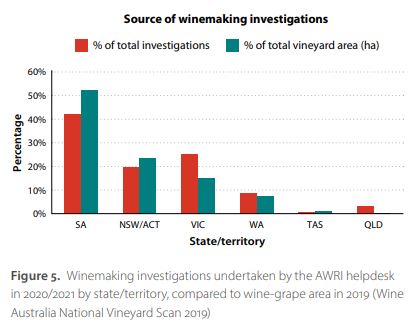
Winemaking investigations are assigned to five main categories: hazes and deposits; sensory investigations; microbiological issues; taints and contaminations; and other. The proportion of investigations in each category has remained relatively consistent over the last ten years, with approximately 20% in each category (Figure 6). Closures is an additional category where investigations were common in the past; however, investigations in this category are now relatively rare because of the widespread uptake in Australia of non-cork-based closures.
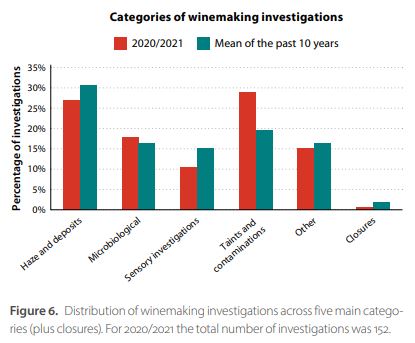
Hazes and deposits
Haze and deposit investigations were nearly equally split between heat and cold instabilities. In addition, there were several deposits in packaged wine where the material was likely remnants of a biofilm that had become non-viable and had absorbed phenolic material from wine. Biofilms are extracellular polymeric substances secreted by microbes. The polymers are made up of polysaccharides, proteins, nucleic acids and lipids. These substances allow biofilms to adhere to surfaces, making them harder to remove with general cleaning. They can reside in dead spaces of bottling lines, hoses, pumps, valves or under seals and become dislodged upon occasion. The AWRI website includes a series of pages on cleaning and sanitation practices in the winery, in barrels and during packaging.
Microbiological issues
Some wineries reported higher acetic acid production in some white ferments this vintage. Investigations highlighted possibly elevated loads of microorganisms or Botrytis on fruit which may not have been obvious by visual assessment. Another investigation worked with a winery and vineyard to re-examine if Brettanomyces could be sourced from the vineyard. The company reported that one small parcel of a vineyard had consistently produced Brettanomyces in wine made in tank over seven years, whereas the surrounding vineyards had not. Throughout this investigation, no Brettanomyces yeast could be detected across different sections of the vineyard, in wine made at the winery or in wine made off-site at the AWRI under conditions favourable to Brettanomyces growth. These results are consistent with earlier studies suggesting that the vineyard is not a primary source of Brettanomyces in wine.
Sensory investigations
Sensory issues investigated by the helpdesk are often related to either oxidation or sulfide development. This year sensory investigation numbers decreased by about half of last year’s figure (Figure 7); however, the number of taint investigations increased by a similar amount (Figure 8). Of the sensory investigations, sulfide-related faults were predominant and indole formation in sparkling wine continued to be a concern. An indole degradation trial conducted by the helpdesk team saw a sparkling wine with 114 µg/L of indole (threshold 23 µg/L) degrade to 7 µg/L only after 18 months of bottle ageing.
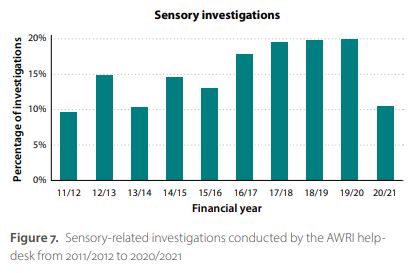
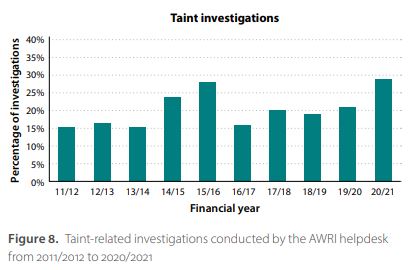
Taints and contaminations
Taints and contamination queries during the year covered topics including:
- brine leaks, hydraulic oil contaminations and burnt pump stators during vintage
- contaminations caused by using non-standard wine vessels or equipment
- contamination of winemaking materials and facilities during the mouse plague across NSW and Victoria
- a herbaceous ‘green’ flavour (2-isopropyl-3-methoxypyrazine) caused by ladybirds in several batches of wine across two regions (possibly related to the cooler season).
Taints and contamination investigations included:
- comparisons of smoke analytical results with the sensory perception of ‘smoky’ characters as assessed by the AWRI quality panel
- batches of wine reported to be affected by a ‘musty’ taint resulting from a batch of tainted dry ice. In conjunction with the flavour team, helpdesk staff confirmed the ‘musty’ taint was not any of the typical bromo- or chloroanisoles in the existing analysis suite. GC-MS analysis confirmed the taint compound of interest was also not any previously reported compound known to cause ‘musty’ taints in wine. Further analysis resolved the taint compound of interest, but additional work is needed to concentrate and identify it.
- a product cross-contaminated by bisabolol, a sesquiterpene compound, which has a ‘sweet’, ‘floral’ aroma. Bisabolol is a common ingredient in cosmetic and other personal care products, as well as tea, but is not naturally present in wine.
- wines affected by tainted sterile filters, tainted cross-flow filtration equipment, tainted water and chlorine-based cleaning agents.
Other investigations
A number of investigations examined gushing or excessive spritz levels in white and red wines sealed with both screwcap and natural cork closures and in sparkling wine. Causes of spritz in table wines included elevated pressures being used at bottling; increased dissolved carbon dioxide concentrations; overfills and increased pressures following heating during transport; and refermentation. Gushing issues in sparkling wine were predominantly due to either inadequate riddling or cold instability issues. An article on gushing was written to provide further information to industry.
Fermentation and level sensor trials
Trials were performed on a range of in-tank fermentation and level sensors at a commercial winemaking scale. This included pressure transducers, radar, hydrogen sulfide and oxygen reduction potential probes. Trials were mainly performed on white ferments, with some initial experiments also performed on red ferments. Differential pressure measurement effectively tracked both ferment density and tank levels during white ferments and during wine storage. Radar also allowed effective level measurement but was more complex to fit to tanks if levels were to be measured up into the neck without impeding access.
Low-flow commercial bubbler-type pressure-based systems also effectively tracked ferment density. Red ferments were more challenging than white ferments because of the presence of skins, particularly early in ferments before the skins had risen. Significant advances were made on designing screens for these devices for use in red ferments to make them more practical.
Project Contacts
Con Simos, Geoff Cowey

